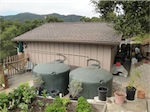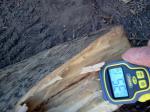Most of this blog is from the “Help Yourself to a Healthy Home” guide from HUD. We generally suggest hiring an established remediation company with professionals certified by the IICRC but many cannot afford to pay for that service or don’t feel it’s necessary.
Personal Protective Equipment (PPE) for Mold
Protect yourself when cleaning up mold. Wear long sleeves and pants, shoes and socks, rubber gloves, goggles to protect your eyes, and a N-95 respirator. Open a window to let in fresh air while you’re working. Professionals have protocols that call for “donning” full body suits that cover their shoes and even have a hood to cover their hair. There is an order to “don” and “doff” PPE, and that is part of what IICRC Mold Remediation classes cover.
What to Throw Away if Moldy?
Throw away things like carpet or mattresses, wallboard (drywall), ceiling tile, insulation, or cardboard boxes that have been wet for more than two days. Wrap anything you’re going to throw away in plastic to stop mold from spreading. Cleaning up mold puts the spores in the air so it’s a good idea to wear a respirator. Keep small children, elderly and sick people, and anyone with allergies or asthma away during cleanup.
Clean hard surfaces with a mix of laundry detergent or dishwashing soap and water. You may have to scrub with a brush. Rinse the area with clean water and dry quickly by wiping away the water and using a fan. Chlorine bleach will kill mold growing on surfaces. It does not kill mold spores in the air and dead mold can still cause allergic reactions. If you use bleach, follow these steps:
- Scrub the surface first with water and detergent.
- Water down the chlorine bleach—use about one cup bleach to ten cups of water.
- Spray or sponge the bleach on the moldy area. Leave it on about 15 minutes, then rinse the area and dry quickly.
- Never mix chlorine bleach with products that contain ammonia or acids because you will make a deadly gas.
- Keep chlorine bleach out of the reach of pets and children.
- Remember, chlorine bleach takes the color out of most fabrics and rugs. Be careful not to spill or splash.
The Cooperative Extension Service or your local or state health department can provide more information on mold. Renters should talk to their landlords. Some home insurance policies will pay to fix mold damage. Fire and Water Damage Restoration professionals can help you fix the damage. Cleaning up a big mold problem may cost several thousand dollars or more.








